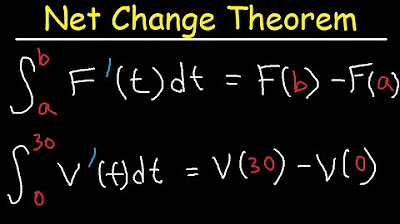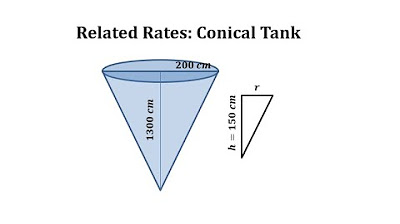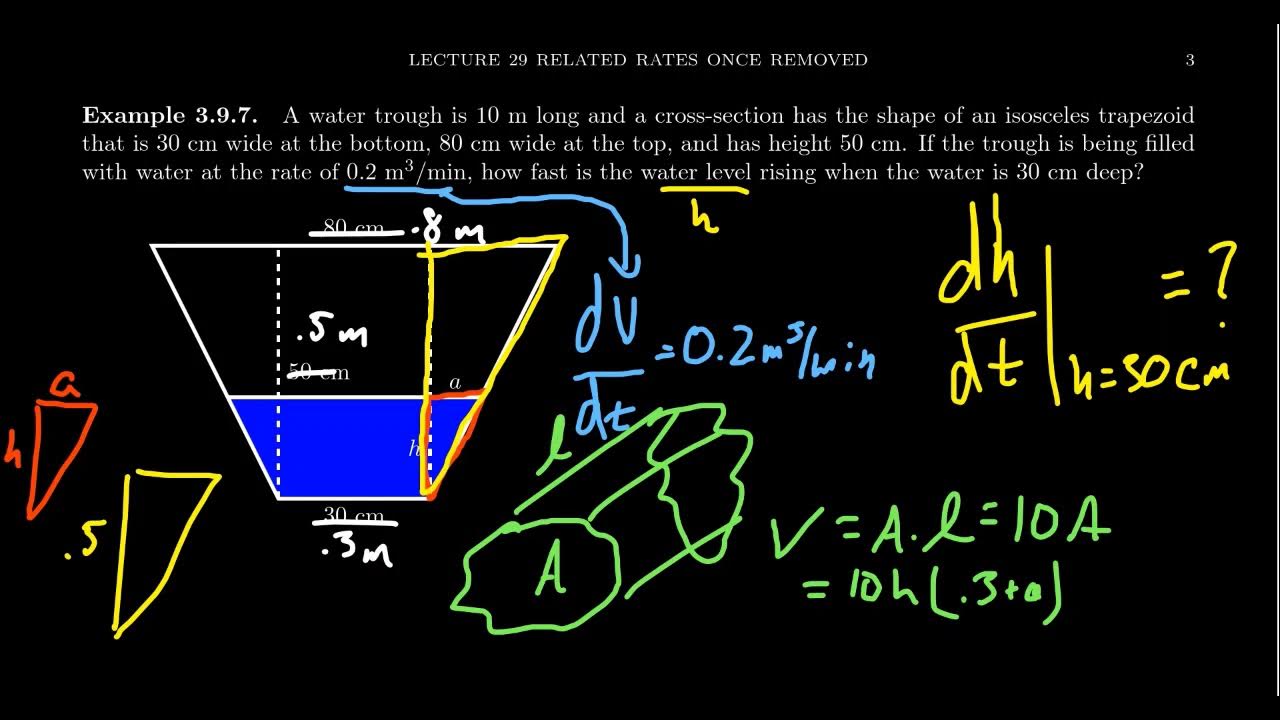Worked example: problem involving definite integral (graphical) | AP Calculus AB | Khan Academy
TLDRThe video script describes a scenario where Jughead discovers a leak in his hot tub and proceeds to open the drain, leading to the water being drained at varying rates over a period of 60 minutes. The challenge is to calculate the original volume of water in the hot tub by analyzing the rate of drainage, which increases from 1 gallon per minute to 20 gallons per minute and then decreases over time. The solution involves understanding the concept of areas under a curve, which represents the volume drained during different time intervals. By calculating the areas of the triangular and rectangular sections under the curve, the total volume of water drained is determined to be 620 gallons, indicating the hot tub's initial water volume.
Takeaways
- 🕰️ Jughead noticed the hot tub leak after 20 minutes, which is key to understanding the water loss.
- 💧 Once the leak was discovered, Jughead opened the drain and the water drained at an increasing rate.
- 📈 The initial rate of water drainage was 1 gallon per minute at the 10-minute mark, doubling to 2 gallons per minute at 20 minutes.
- 🚽 Upon opening the drain, the water drainage rate surged to 20 gallons per minute and then gradually decreased.
- 🔄 The total amount of water drained from the hot tub was the sum of the areas under the curve representing the rate of drainage over time.
- 📊 The script describes a graph with gallons per minute on one axis and time in minutes on the other, illustrating the rate of drainage.
- 🥂 Jughead's bath ended up being 60 minutes long, with all the water drained by the end of this period.
- 🔢 To calculate the total water drained, the script suggests breaking down the time intervals and calculating the area under the curve for each.
- 🔵 The triangular section represents the initial 20 minutes of drainage at an increasing rate, contributing 20 gallons to the total.
- 🟩 The green section represents the 40 minutes after the drain was opened, at a constant rate of 10 gallons per minute, totaling 400 gallons.
- 🟦 The blue section is a trapezoid representing the transition from 10 to 20 gallons per minute, adding 200 gallons to the total.
- 🏆 The final total of water drained from the hot tub was 620 gallons, indicating the hot tub's initial capacity before the leak started.
Q & A
How long did it take Jughead to notice the leak in the hot tub?
-It took Jughead 20 minutes to notice the leak in the hot tub.
What was the initial rate of water drainage from the hot tub before Jughead opened the drain?
-Initially, at minute zero, the water wasn't draining from the hot tub.
How did the rate of water drainage change 10 minutes into Jughead's bath?
-Ten minutes into the bath, the water was draining at a rate of one gallon per minute.
What was the water drainage rate 20 minutes into Jughead's bath?
-Twenty minutes into the bath, the water was draining at a rate of two gallons per minute.
What action did Jughead take upon noticing the leak, and what was the immediate effect on the water drainage rate?
-Upon noticing the leak, Jughead opened the hot tub's drain, after which the water started draining at a much higher rate of 20 gallons per minute.
How long did it take for all the water to be drained out after Jughead opened the drain?
-It took 40 minutes for all the water to be drained out after Jughead opened the drain.
What is the total amount of water that was in the hot tub before it started to leak?
-The total amount of water that was in the hot tub before it started to leak was 620 gallons.
How was the total amount of drained water calculated?
-The total amount of drained water was calculated by determining the area under the curve of the rate of drainage over time, which is equivalent to the sum of the areas of the triangle, rectangle, and the trapezoid formed by the rate changes.
What is the area of the triangular section formed by the initial rate of drainage?
-The area of the triangular section is calculated as 20 minutes times two gallons per minute times 1/2, which equals 20 gallons.
What is the area of the green section, representing the period after Jughead opened the drain?
-The area of the green section is 40 minutes times 10 gallons per minute, which equals 400 gallons.
How was the area of the blue section, representing the decreasing rate of drainage after the drain was opened, calculated?
-The area of the blue section is calculated as 40 times the height (which is between 10 and 20 gallons per minute) times 1/2, resulting in 200 gallons.
What type of mathematical concept is used to calculate the total drained water?
-The mathematical concept used to calculate the total drained water is the calculation of areas under a curve, which can be broken down into simpler shapes like triangles and trapezoids for easier computation.
Outlines
🛁 Jughead's Hot Tub Leak Discovery
In this paragraph, Jughead realizes that his hot tub has developed a leak after 20 minutes of use. Initially, the water drains at a rate of 1 gallon per minute, which increases to 2 gallons per minute by the 20-minute mark. Once Jughead opens the drain, the rate of drainage jumps to 20 gallons per minute but gradually decreases over the next 40 minutes, until all the water is drained by the 60th minute. The paragraph introduces the concept of using the rate of water drainage to determine the total amount of water originally in the hot tub.
📊 Calculating Total Drained Water
This paragraph delves into the mathematical aspect of calculating the total amount of water drained from the hot tub. It breaks down the drainage process into different sections, each with varying rates of drainage, and uses the concept of calculating the area under a curve to determine the total volume of water drained. The first section is a triangle representing the initial 20 minutes of drainage at 1 gallon per minute, resulting in 20 gallons. The second section is a rectangle representing the subsequent 40 minutes of drainage at 10 gallons per minute, totaling 400 gallons. The final section is a trapezoid representing the 40 minutes after the drain was opened, with the rate decreasing from 20 to 10 gallons per minute, resulting in an additional 200 gallons. The sum of these areas gives the total drained water, which is 620 gallons.
Mindmap
Keywords
💡hot tub
💡leak
💡drain
💡rate
💡gallons per minute
💡time
💡area under the curve
💡calculus
💡trapazoid
💡volume
💡Jacuzzi
Highlights
Jughead noticed his hot tub had sprung a leak after 20 minutes.
Upon realizing the leak, Jughead opened the hot tub's drain, and the water drained out over 40 minutes.
A graph was plotted showing gallons per minute versus time in minutes to represent the rate of water drainage.
At minute zero, there was no drainage, but as time progressed, the rate of drainage increased.
Ten minutes into the bath, the water was draining at a rate of one gallon per minute.
Twenty minutes into the bath, the drainage rate doubled to two gallons per minute.
After opening the drain, the drainage rate surged to 20 gallons per minute and then gradually decreased.
By the 60th minute, all the water had been drained out of the hot tub.
The total amount of water drained out equates to the initial amount of water in the hot tub before the leak.
The calculation of the total drained water involves finding the area under the curve of the graph from 0 to 60 minutes.
The area under the curve can be calculated by multiplying the rate over an interval of time by the length of that interval.
The method of calculating the area under the curve is analogous to finding the area of a trapezoid.
The area of the triangle representing the first 20 minutes of drainage is calculated as 20 minutes times 2 gallons per minute times 1/2.
The green section represents 40 minutes of drainage at a rate of 10 gallons per minute.
The blue section represents 40 minutes of drainage at a rate decreasing from 20 to 10 gallons per minute, with an average rate used for calculation.
The total calculated amount of water drained out is 620 gallons, which is the initial amount of water in the hot tub.
The problem and its solution demonstrate the practical application of mathematical concepts such as rates and areas under curves.
The scenario and solution are applicable to real-world situations like calculating the capacity of a hot tub or a similar container.
Transcripts
Browse More Related Video

calculus 2 mixing problem, CSTR, differential equation application

Net Change Theorem - Calculus Word Problems

Related Rates - Filling a Cone Problem

Related Rates Applicate: Leaking Conical Tank

Related rates: water pouring into a cone | AP Calculus AB | Khan Academy

Related Rates and a Trapezoidal Trough
5.0 / 5 (0 votes)
Thanks for rating: